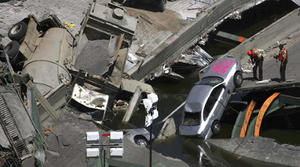Small bridge sensors will give early warnings of anomalies, weaknesses
University of Maryland researchers devised a lightweight, low-power, wireless, credit card-sized sensor that will detect weaknesses in bridges and other infrastructure before they can turn into calamities; the sensors would detect anomalies in the structure of even the most inaccessible parts of bridges and send alerts via cellular frequencies to its human masters. Among the things it would measure would be stress loads, vibration, temperature and the creation and growth of cracks

Soon to be a thing of the past? // Source: electronicsweekly.com
The device that Mehdi Kalantari hopes will revolutionize monitoring of the structural integrity of bridges around the world is about as small and flat as a credit card and is powered by the sun, by ambient light, or even by stray radio waves it can pick out of the atmosphere.
An Iranian immigrant and electrical engineer at the University of Maryland, College Park, Kalantari has devised what he calls a lightweight, low-power, wireless sensor that he hopes will detect weaknesses in bridges and other infrastructure before they can turn into calamities such as the collapse of the Interstate 35W bridge that killed thirteen people in Minneapolis in 2007.
If they work as imagined, the devices would detect anomalies in the structure of even the most inaccessible parts of bridges and send alerts via cellular frequencies to its human masters. Among the things it would measure would be stress loads, vibration, temperature and the creation and growth of cracks.
“You will have a complete, real-time picture of what’s happening on the bridge,” said the 35-year-old UM researcher who has lived in the United States since 2001.
The Baltimore Sun’s Michael Dresser writes that like all new technologies, Kalantari’s sensor faces enormous hurdles in finding a market. It would need to win acceptance from the engineers who maintain the U.S. transportation infrastructure and it would have to prove itself against the competition that could arise from other universities and corporate laboratories anywhere in the world.
Kalantari’s colleagues and advisers at UM’s Technology Advancement Program believe the entrepreneur and his business partner, fellow UM electrical engineer Arash Takshi, might be on to something big.
Kalantari and Takshi’s startup company, Resensys, won a $6,000 grant in a business plan challenge from the university in 2008 and a free year of work space on the UM campus. Just this month, Resensys launched a pilot project under which it has installed a half-dozen sensors monitoring conditions on a more-than-50-year-old bridge on the Capital Beltway under an agreement with the State Highway Administration.
“The technology they offer clearly affords us an entrepreneurial opportunity,” said Craig Dye, director of UM’s Venture Accelerator program. While designed with bridges in mind, he said, the sensors could be applied to roads, trestles and buildings, too.
Other sensors have been invented to monitor infrastructure for signs of cracking or metal fatigue, but what distinguishes the Resensys device is its miserly use of power— about 4 microwatts, or
